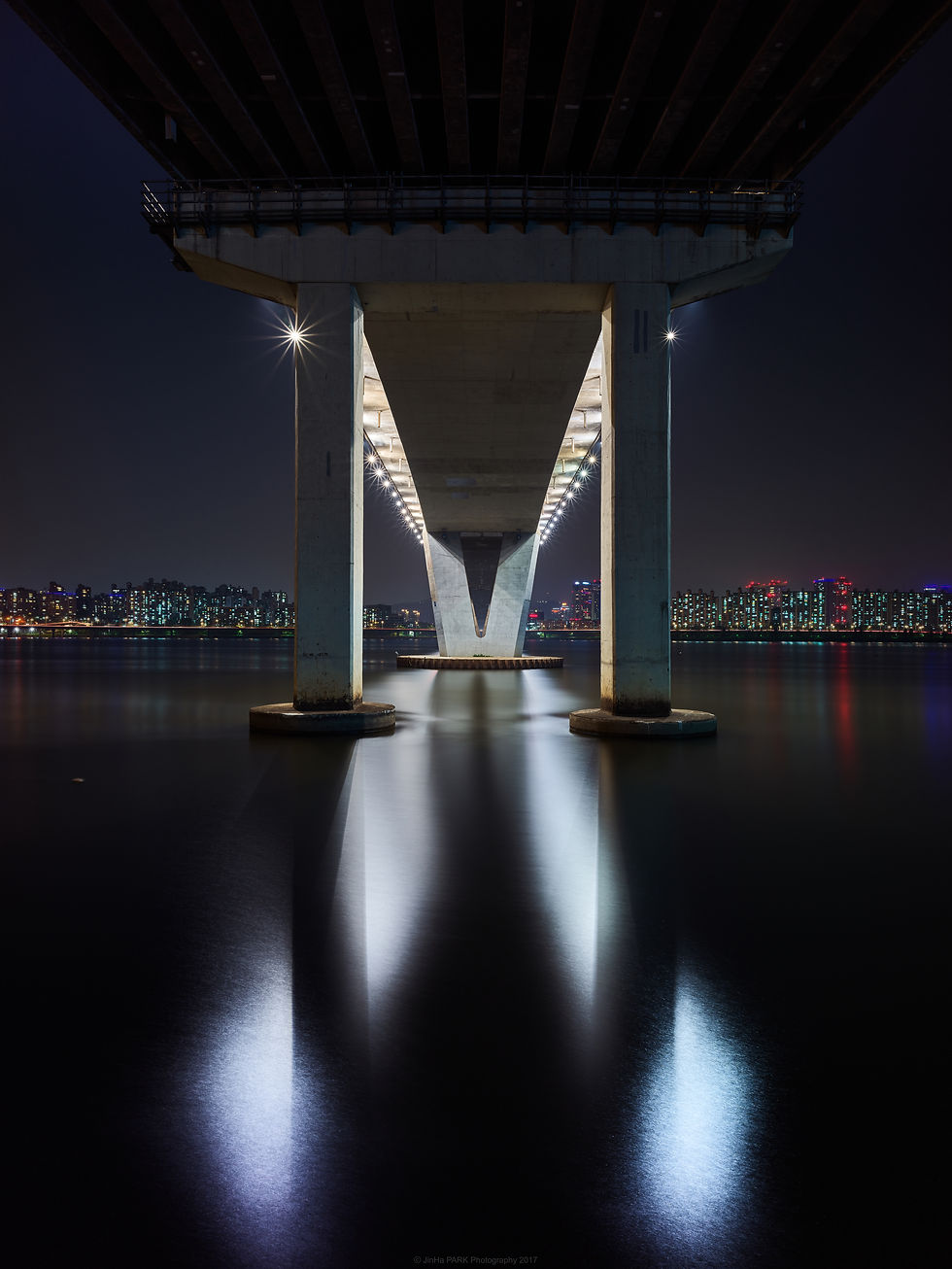Girders and Coulums
Hidden Layers: Infrastructural Seoul and the Invisible Narrative
숨겨진 층위들: 서울의 도로, 구조물, 그리고 비가시적 서사.
서울은 한강을 중심으로 살아 움직인다. 도시의 중심을 가로지르는 이 강은 단지 자연의 경계선이 아니라, 도시를 남과 북으로 나누고 다시 연결하는 하나의 동맥이다. 그 위를 가로지르는 27개의 대형 교각과, 이를 이어주는 남측의 올림픽대로, 북측의 강변북로는 단순한 교통망이 아닌, 서울이라는 초거대 도시의 호흡과 순환을 관장하는 신경망과도 같다. 박진하 작가의 Hidden Layers는 이러한 도시적 인프라를 단순한 기능적 구조물로 보지 않는다. 그는 서울을 '이용자'로서의 시각이 아니라, 그 구조물들이 가진 존재론적 의미, 물리적 구성의 미학, 그리고 그것을 둘러싼 시간의 축적을 탐색하는 사유의 렌즈로 바라본다. 마치 해부학자가 인체를 절개해 생명의 원리를 들여다보듯, 작가는 도로망과 교각 구조를 해석하며 도시의 숨겨진 층위를 드러낸다.
작가는 교각의 기능적 면모—상부 구조물, 도로 면의 질감과 형식, 공간 구성의 리듬—뿐 아니라, 하부 구조물의 공학적 미학, 시각적 프레임 형태, 그리고 레이어의 연속성과 중첩성을 예술가의 시선과 건축가의 사유로 읽어낸다. 이 작업은 서울이라는 도시가 낮과 밤을 관통하며 드러내는 다양한 결들을 읽고 기록한 하나의 서사이기도 하다. 그의 사진은 단순히 대상을 포착하는 것을 넘어서, 시각을 형상화하고 입체화하는 실천이다. 그는 병치되고 축적된 레이어들을 샅샅이 찾아내며, 그 속에 얽혀 있는 구조적·시간적 조각들을 다시 재조합한다. 한강의 다리들, 기둥과 보들, 도시의 하부 구조에 스며든 세월의 단층들을 작가는 감각적으로 추출해낸다. 이는 곧 보이지 않는 도시의 논리를 시각화하는 작업이며, 도시의 무의식에 접근하는 일종의 시지각적 해체이자 재구성이다. 사진 속에 담긴 교각은 그 자체로 하나의 기념비적 풍경이자, 도시에 내재된 질서와 리듬을 은유하는 기호다. 반복되는 콘크리트 기둥, 수직과 수평의 교차, 그리고 그 사이로 스며드는 빛과 그림자는 건축적 조형의 언어로 기능하며, 도시의 구조가 품고 있는 무의식적 질서를 시각화한다. 그 질서는 인간이 도시와 관계 맺는 방식, 공간을 이동하고 감각하는 방식, 그리고 궁극적으로는 도시를 '살아가는' 방식과 직결된다.
Hidden Layers는 시각적으로는 철저하게 구조적이지만, 정서적으로는 깊이 감응적이다. 이는 마치 베르나르 츄미가 언급한 공간과 사건의 교차점처럼, 정적인 구조물 속에서도 수많은 이야기가 발생하고 있음에 주목하게 만든다. 구조는 단순히 공간을 나누는 것이 아니라, 시간을 저장하고 사건을 가능하게 하는 매개가 된다. 이런 점에서 이 시리즈는 도로와 교각이라는 익숙한 풍경을 통해 도시가 가진 시간적 깊이와 감각의 스펙트럼을 드러낸다.
박진하 작가는 메가시티이자 메가스트럭처, 그리고 메가컬처로서 해석되는 서울이라는 도시를 명확히 읽어내며, 그것을 현시대에 기록하고 있다. 궁극적으로 그의 작업은 하나의 질문으로 귀결된다. 우리는 지금, 어떤 도시를 살아가고 있는가? 혹은 우리는 도시라는 거대한 장치 속에서 무엇을 보고, 무엇을 놓치고 있는가? 작가의 시선은 차가운 거리감에서 출발하지 않는다. 오히려 교각 아래 어둠 속에 가라앉은 구조적 의미를 꺼내 들며, 우리에게 도시를 다시 읽을 수 있는 감각을 회복시킨다. 이 감각은 도시의 피부 아래 숨겨진 레이어들, 즉 서울이란 도시가 형성되고 작동하는 물리적, 역사적, 감정적 구조를 비로소 마주하게 한다.



































Hidden Layers: Infrastructural Seoul and the Invisible Narrative
Seoul thrives along the great artery of the Han River. This river, which cuts through the heart of the metropolis, is not merely a natural boundary, but a vital line that divides and reconnects the city’s north and south. Spanning its breadth are twenty-seven grand bridges, linked by the Olympic Highway to the south and the Gangbyeonbuk-ro to the north—networks that function less as mere transportation routes and more as the nervous system of this sprawling megacity.In Hidden Layers, artist Jin-ha Park does not regard these infrastructural elements as mere functional structures. Instead, through the lens of contemplative inquiry, he explores their ontological weight, their material aesthetic, and the strata of time that cling invisibly to their forms. Much like an anatomist who incises the body to understand the secret workings of life, Park dissects the network of bridges and roadways to reveal the city’s hidden layers.The artist overlays his vision both as an artist and as an architect, examining the bridges’ structural surfaces—their upper constructions, the textures and patterns of their roadways, the rhythmic articulation of their spaces—as well as the engineering aesthetics of their substructures, the visual framing of forms, and the continuous and overlapping layers embedded within them. His practice narrates a slow, attentive reading of the city’s unfolding surfaces through the transitions of day and night.Park’s images are not passive recordings; they are acts of spatial crystallisation and dimensional vision. He meticulously uncovers the strata—juxtaposed, accumulated, hidden—and reconfigures their latent structures and temporal fragments. Bridges, pillars, and beams are unearthed with an almost archaeological precision, their invisible histories distilled into sensory form. It is a visualisation of the city's silent logic, an excavation of its unconscious, executed through perceptual deconstruction and reconstruction.In these photographs, the bridge is at once a monumental landscape and a signifier of the city’s underlying order and rhythm. Repetitive concrete columns, the intersections of verticals and horizontals, and the play of light and shadow weaving through them operate as an architectural language, revealing an unconscious geometry within the city’s corporeal frame. Such structures are not merely spatial partitions; they become vessels of time, enabling events and harbouring memory.Visually rigorous yet emotionally resonant, Hidden Layers invites the viewer to sense, in Bernard Tschumi’s terms, the collision of space and event. Within the ostensibly inert concrete and steel, the city’s myriad narratives are silently unfolding.
Through these familiar yet unremarked structures, Park reveals Seoul’s temporal depths and the spectrum of urban sensation.Through his work, Jin-ha Park reads Seoul—this megacity, this megastructure, this megaculture—with an unflinching clarity, recording its essence as a testament to our present epoch. His exploration ultimately converges upon a profound question: What city are we truly living in? Or more urgently, Within the vast apparatus of the city, what do we perceive—and what do we overlook?Park’s gaze does not remain aloof; rather, it draws forth the submerged meanings lying dormant beneath the overpasses and pillars. He restores to us the rare ability to read the city anew—to recognise its silent architectures and hidden emotional geographies.Through his images, we confront the unseen layers beneath the skin of Seoul: the physical, historical, and emotional frameworks through which the city is shaped, operates, and endures.



































COMING SOON